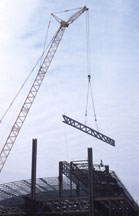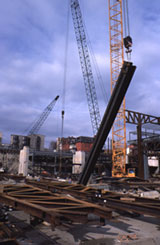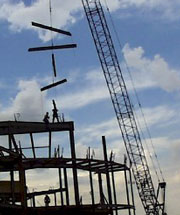Cranes
1926.753
Hoisting and rigging
 Rigging and hoisting of steel members and materials are
essential parts of the steel erection process. However, in
addition to the dangers usually associated with cranes and
derricks, steel erection also presents specialized
hazards, such as the use of cranes to hoist employees, suspend loads over certain employees, and
perform
multiple lifts.
Because of the specialized nature of these hazards, the
provisions below are intended to supplement, rather than
displace, the requirements of 1926.550, the OSHA
standard covering cranes and derricks in general
construction. Rigging and hoisting of steel members and materials are
essential parts of the steel erection process. However, in
addition to the dangers usually associated with cranes and
derricks, steel erection also presents specialized
hazards, such as the use of cranes to hoist employees, suspend loads over certain employees, and
perform
multiple lifts.
Because of the specialized nature of these hazards, the
provisions below are intended to supplement, rather than
displace, the requirements of 1926.550, the OSHA
standard covering cranes and derricks in general
construction.
|
-
In addition to paragraphs
1926.753(c)
through
1926.753(e),
all the provisions of
1926.550
apply to hoisting and rigging with the exception of 1926.550(g)(2),
[1926.753(a)],
and [1926.753(b)].
- The crane operators must be responsible for operations under their
direct control. Whenever there is any doubt as to safety, the operator
must have the authority to:
- stop all hoisting activities, and
- refuse to handle loads until
safety has been assured. [1926.753(c)(1)(iv)]
- Cranes or derricks may be used to hoist employees on a personnel platform
when steel erection is being conducted, provided that all provisions of 1926.550
(except for 1926.550(g)(2))
are met. [1926.753(c)(4)]
-
 The headache ball, hook or load must not be used to transport personnel
except as provided in paragraph [1926.753(c)(4)] of this section.
[1926.753(c)(3)] The headache ball, hook or load must not be used to transport personnel
except as provided in paragraph [1926.753(c)(4)] of this section.
[1926.753(c)(3)]
- Safety latches on hooks must not be deactivated or made inoperable
except: [1926.753(c)(5)]
- when a qualified rigger has determined that the hoisting and placing of
purlins and single joists can be performed more safely by doing so; [1926.753(c)(5)(i)] or
- when equivalent protection is provided in a site-specific erection plan.
[1926.753(c)(5)(ii)]
|
|
- Before each shift, cranes being used in steel erection activities must be
visually inspected by a competent person. The inspection must include
observation for deficiencies during operation, including, at a
minimum [1926.753(c)(1)(i)]:
- lubricants,
- water, or
- other foreign matter.
- safety devices, including but not limited to:
- boom-angle indicators,
- boom stops,
- boom kick-out devices,
- anti-two block devices, and
- load moment indicators where required [1926.753(c)(1)(i)(C)];
- air, hydraulic, and other pressurized lines, especially
those that flex during operation, for:

- hooks and latches for
- wire rope reeving for compliance with hoisting equipment manufacturer's
specifications [1926.753(c)(1)(i)(F)];
- electrical apparatus for:
- malfunctioning,
- signs of excessive
deterioration,
- dirt, or
- moisture accumulation [1926.753(c)(1)(i)(G)];
- hydraulic system for proper fluid level [1926.753(c)(1)(i)(H)];
- tires for proper inflation and condition [1926.753(c)(1)(i)(I)];
-
ground conditions around the hoisting equipment for:
- proper support, including ground settling under and around outriggers,
- ground water accumulation, or
- similar conditions [1926.753(c)(1)(i)(J)];
- the hoisting equipment for level position [1926.753(c)(1)(i)(K)];
and
- the hoisting equipment for level position after each move and
setup [1926.753(c)(1)(i)(L)].
- If any deficiency is identified, an immediate determination must be
made by the competent person as to whether the deficiency constitutes a
hazard [1926.753(c)(1)(ii)].
- If the deficiency is determined to constitute a hazard, the hoisting
equipment must be removed from service, until the deficiency has been
corrected
[1926.753(c)(1)(iii)].
- A qualified rigger (a rigger who is also a qualified person) must inspect the rigging prior to each shift in accordance with
1926.251 [1926.753(c)(2)].
|
|
- Routes for suspended loads must be preplanned to ensure that no
employee is required to work directly below a suspended load, except for [1926.753(d)(1)]
 : :
- When employees work under suspended loads, the following criteria must be
met [1926.753(d)(2)]:
- Materials being hoisted must be rigged to prevent unintentional
displacement [1926.753(d)(2)(i)];
- Hooks with self-closing safety latches or their equivalent must be used
to prevent components from slipping out of the hook [1926.753(d)(2)(ii)]; and
- All loads must be rigged by a qualified rigger [1926.753(d)(2)(iii)].
|
|
- A multiple lift may be performed only if the following criteria are
met [1926.753(e)(1)]:
- All employees engaged in the multiple lift have been trained in these
procedures in accordance with 1926.761(c)(1)
[1926.753(e)(1)(iv)];
- No crane is permitted to be used for a multiple lift where such use is
contrary to the manufacturer's specifications and limitations [1926.753(e)(1)(v)].
- Multiple-lift rigging assembly capacity, for the total
assembly and for each individual attachment point, must:

- be certified by the manufacturer or a
qualified rigger,
- be based on the manufacturer's specifications, and
- have a 5-to-1 safety factor for all components [1926.753(e)(2)].
- The total load must not exceed:
- the rated capacity of the hoisting equipment specified in
the hoisting
equipment load
charts [1926.753(e)(3)(i)];
and
- the rigging capacity specified in the rigging rating
chart [1926.753(e)(3)(ii)].
- The multiple-lift rigging assembly must be rigged with members:
- The members on the multiple-lift rigging assembly must be set
in position from the
bottom up [1926.753(e)(5)].
- Controlled load lowering must be used whenever the load is over the
connectors [1926.753(e)(6)].
|
|
Commercially manufactured lifting equipment designed to lift and
position a load of known weight to a location at some known elevation and
horizontal distance from the equipment’s center of rotation.
A "come-a-long" (a mechanical device usually consisting of a
chain or cable attached at each end, that is used to facilitate movement
of materials through leverage) is not considered "hoisting
equipment."
 |
 |
 |
 |
 |
|
Cranes |
Headache Ball |
Choker |
Multiple Lift Rigging |
Multi-Lift Rigging Procedure (MLRP) |
|
|
|
|
|
